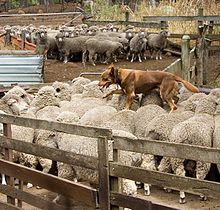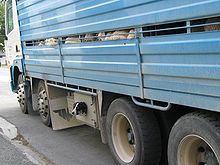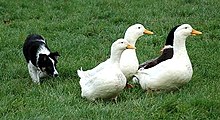Herding dog



Fairlie, New Zealand
A herding dog, also known as a stock dog, shepherd dog, sheepdog or working dog, is a type of dog that either has been trained in herding or belongs to breeds that are developed for herding.
Herding behavior[]

All herding behavior is modified predatory behavior. Through selective breeding, humans have been able to minimize the dog's natural inclination to treat cattle and sheep as prey while simultaneously maintaining the dog's hunting skills, thereby creating an effective herding dog.[1][2]
Dogs can work other animals in a variety of ways. Some breeds, such as the Australian Cattle Dog, typically nip at the heels of animals (for this reason they are called heelers) and the Cardigan Welsh Corgi and the Pembroke Welsh Corgi were historically used in a similar fashion in the cattle droves that moved cattle from Wales to the Smithfield Meat Market in London but are rarely used for herding today.
Other breeds, notably the Border Collie, get in front of the animals and use what is called strong eye to stare down the animals;[3] they are known as headers. The headers or fetching dogs keep livestock in a group. They consistently go to the front or head of the animals to turn or stop the animal's movement. The heelers or driving dogs keep pushing the animals forward. Typically, they stay behind the herd. The Australian Kelpie and Australian Koolie use both these methods and also run along the backs of sheep so are said to head, heel, and back.[1][2][4] Other types such as the Australian Shepherd, English Shepherd and Welsh Sheepdog are moderate to loose eyed, working more independently. The New Zealand Huntaway uses its loud, deep bark to muster mobs of sheep.[5] Belgian Shepherds, German Shepherd Dogs and Briards are historically tending dogs, who act as a "living fence," guiding large flocks of sheep to graze while preventing them from eating valuable crops and wandering onto roads.
Herding instincts and trainability can be measured when introducing a dog to livestock or at noncompetitive herding tests. Individuals exhibiting basic herding instincts can be trained to compete in herding trials.[6]
Terminology[]
In Australia, New Zealand and the United States herding dogs are known as working dogs irrespective of their breeding.[7] Some herding breeds work well with any kind of animals; others have been bred for generations to work with specific kinds of animals and have developed physical characteristics or styles of working that enhance their ability to handle these animals. Commonly mustered animals include cattle, sheep, goats and reindeer,[6] although it is not unusual for poultry to be handled by dogs.[1]
The term "herding dog" is sometimes erroneously used to describe livestock guardian dogs, whose primary function is to guard flocks and herds from predation and theft, and they lack the herding instinct. Although herding dogs may guard flocks their primary purpose is to move them; both herding dogs and livestock guardian dogs may be called "sheep dogs".
In general terms when categorizing dog breeds, herding dogs are considered a subcategory of working dogs, but for conformation shows they usually form a separate group.
Australia has the world's largest cattle stations and sheep stations and some of the best-known herding dogs, such as the Koolie, Kelpie, Red and Blue Heelers are bred and found there.
Origins of herding dogs[]
Creating herding dog breeds is associated with the development of cattle breeding. Domestication of sheep and goats began in the 8-7th millennium BC. Originally this process began in Western Asia, on the territory of modern Iran and Iraq. Shepherding was a difficult task: primitive herders did not have horses and moved their cattle for grazing on foot as horses and donkeys were not yet fully domesticated and obedient enough. Dogs that were previously helping humans in hunting, became assistants in livestock maintenance. The main task for dogs in the early stages of cattle breeding was protecting herds from a variety of wild predators, that were very numerous.[8]

This function predetermined herding dogs characteristics: they had to be strong, vicious, courageous, decisive, able to stand alone against a large predator and, most importantly, ready to defend their herd. The history of the ancestors of herding dogs can be traced back to six thousand years ago, archaeological findings of the joint remains of sheep and dogs date back to 3685 BC.[9] The place of their origin is considered to be the territories of modern Turkey, Iraq and Syria. Shepherd dogs are mentioned in the Old Testament, the writings of Cato the Elder and Varro, their images are found in works of art created more than two thousand years ago. These dogs were used not only to guard herds, but also for military purposes.[10]
From the regions of Western Asia, herding spread to west and north, followed by an increase in the number of domestic animals. On the territory of Europe, the progenitors of herding dogs appeared in the VII-VI centuries BC. According to archaeological research, cattle breeding and agriculture spread across Europe in different ways: along the Danube and Rhine rivers to the territory of modern Germany, northern France and the Netherlands, through the Mediterranean Sea to the Alps, up the Rhone to central and southwestern France.[8][9]
The development of agriculture, increasing number of settlements and foundation of cities have led to a decrease in the number of predators. In the XVI-XVII centuries, after the extinction of large predators in most of Europe and Great Britain, with the massive spread of sheep breeding and with an increase in the share of cultivated and populated land, the main task of herding dogs was to protect crops, private and protected areas from harm during grazing and moving herds. Better than large and strong dogs, medium-sized, more mobile and able to manage a herd shepherd dogs were more suitable for this work. Such dogs managed small and large livestock, as well as domestic birds. In addition to the Central European type of shepherd, another type of dog has emerged, often with thick hair, more suitable for colder areas. These dogs have shown not only the ability to manage the herd, but also to protect it. With the spread of reindeer breeding among the northern peoples, hunting spitz-like dogs were "retrained" into shepherds.[10]
Most breeds of Central European shepherd dogs – with erect ears and short hair on the head, similar to wolves, were mainly formed in the XVI-XVII centuries, the breeds of curly-haired dogs of the Northern European type were formed later.[8]
Physical characteristics[]
During the selection process, the physical characteristics of the dogs were formed, allowing them to do their job in the best possible way. Regardless of the conditions in which herding dogs work and what function they perform, they all have a number of common characteristics. Herding dogs are strong and have a lot of stamina. Their paws are well protected from thorns and sharp stones: toes are compressed into a tight lump, paw pads are thick, claws are strong. The coat has structure and density to protect from getting wet and temperature extremes common in the region of the breed origin. All herding dogs have excellent eyesight and hearing. Cattle dog colors are varied and depend on local breeders preferences, but all dogs should have well-pigmented eyelids, lips, nose and paw pads. Because pink skin is too delicate, prone to wounds and sunburn.
Competitive herding[]

The competitive dog sport in which herding dogs move animals around a field, fences, gates, or enclosures as directed by their handlers is called a sheepdog trial, herding test or stockdog trial depending on the area.[11] Such events are particularly associated with hill farming areas, where sheep range widely on largely unfenced land. These trials are popular in the United Kingdom, Ireland, South Africa, Chile, Canada, the USA, Australia, New Zealand[12] and other farming nations, and have occasionally even become primetime television fare.[13]
In the US, regular events are run by the United States Border Collie Handler's Association, Australian Shepherd Club of America, American Kennel Club and many others.[6]
The world record price for a working sheep dog was broken February 2011 at the auction at Skipton Market, England, with £6,300 ($10,270) for Dewi Fan. The previous record was £5,145 ($8,390)[14]
Basic herding dog commands[]

- Come-bye or just bye - go to the left of the stock, or clockwise around them.
- Away to me, or just away or way - go to the right of the stock, or counterclockwise around them.
- Stand - stop, although when said gently may also mean just to slow down.
- Wait, (lie) down or sit or stay - stop, but remain with that contact on the stock...don't take it off by leaving.
- Steady or take time - slow down.
- Cast - gather the stock into a group. Good working dogs will cast over a large area. This is not a command but an attribute.
- Find - search for stock. A good dog will hold the stock until the shepherd arrives. Some will bark when the stock have been located.
- Get out or back - move away from the stock. Used when the dog is working too close to the stock, potentially causing the stock stress. Occasionally used as a reprimand.
- Keep away or keep - Used by some handlers as a direction and a distance from the sheep.
- Hold - keep stock where they are.
- Bark or speak up - bark at stock. Useful when more force is needed, and usually not essential for working cattle and sheep.
- Look back - return for a missed animal. Also used after a shed is completed and rejoined the flock or packet of sheep.
- In here or here - go through a gap in the flock. Used when separating stock.
- Walk up, walk on or just walk - move in closer to the stock.
- That'll do - stop working and return to handler.
These commands may be indicated by a hand movement, whistle or voice. There are many other commands that are also used when working stock and in general use away from stock. Herding dog commands are generally taught using livestock as the modus operandi. Urban owners without access to livestock are able to teach basic commands through herding games.[6]
These are not the only commands used: there are many variations. When whistles are used, each individual dog usually has a different set of commands to avoid confusion when several dogs are being worked at one time.
Herding dogs as pets[]
Herding dogs are often chosen as family pets. The collie breeds including the Bearded Collie and Border Collie are well known, as are the Australian kelpie and Australian Working kelpie, Welsh Corgis. They make good family dogs and are at their best when they have a job to do.[1] These dogs have been bred as working dogs and need to be physically and mentally active. They retain their herding instincts and may sometimes nip at people's heels or bump them in an effort to 'herd' their family, and may need to be trained not to do so.[1] Their activity level and intelligence makes them excellent canine athletes. The Australian Shepherd, Shetland Sheepdog, Rough Collie, Smooth Collie and Old English Sheepdog are more popular as family companion dogs.[1]
Breed list[]

Herding breeds include the following:
- Australian Cattle Dog
- Australian Kelpie
- Australian Shepherd
- Basque Shepherd Dog
- Beauceron
- Belgian Shepherds
- Groenendael
- Laekenois
- Malinois
- Tervuren
- Bergamasco Shepherd
- Berger Blanc Suisse
- Bouvier des Flandres
- Briard
- Can de Chira
- Caucasian Shepherd
- Can de Palleiro
- Cão da Serra de Aires
- Carea Castellano Manchego
- Carea Leonés
- Canaan Dog
- Catahoula Leopard Dog
- Catalan Sheepdog
- Chiribaya Dog
- Collies
- Bearded Collie
- Border Collie
- Rough Collie
- Scotch Collie
- Smooth Collie
- Welsh Sheepdog
- Croatian Sheepdog
- Cumberland Sheepdog
- Dutch Shepherd
- English Shepherd
- Finnish Lapphund
- Garafian Shepherd
- German Shepherd
- Gaucho sheepdog
- Huntaway
- Icelandic Sheepdog
- Kangal Shepherd Dog
- Koolie
- Komondor
- Lancashire Heeler
- Lapponian Herder
- Magellan sheep dog
- McNab
- Miniature American Shepherd
- Mudi
- New Zealand Heading Dog
- Norwegian Buhund
- Old English Sheepdog
- Pastore della Lessinia e del Lagorai
- Picardy Shepherd
- Polish Lowland Sheepdog
- Polish Tatra Sheepdog
- Portuguese Sheepdog
- Puli dog
- Pumi
- Pyrenean Shepherd
- Rottweiler
- Slovak Cuvac
- Tornjak
- Schapendoes
- Schipperke
- Shetland Sheepdog
- Smithfield[6]
- Swedish Lapphund
- Swedish Vallhund
- Welsh Corgis:
See also[]
- Dogs (Protection of Livestock) Act 1953 (in the UK)
- Livestock guardian dog
- Working dog – Dog used for work
References[]
- ^ Jump up to: a b c d e f Renna, Christine Hartnagle (2008). Herding Dogs: Selection and Training the Working Farm Dog. Kennel Club Books (KCB). ISBN 978-1-59378-737-0.
- ^ Jump up to: a b Hartnagle, Jeanne Joy. Herding I, II, III. Canine Training Systems (CTS).
- ^ "Heading dogs, huntaways and all-purpose dogs", Te Ara
- ^ Hartnagle-Taylor, Jeanne Joy. All About Aussies. Alpine Publications. ISBN 1-57779-074-X.
- ^ "Sheep Herding Dogs". RaisingSheep.net. Retrieved 18 April 2015.
- ^ Jump up to: a b c d e Hartnagle-Taylor, Jeanne Joy; Taylor, Ty (2010). Stockdog Savvy. Alpine Publications. ISBN 978-1-57779-106-5.
- ^ "DOGS, WORKING", 1966, An Encyclopaedia of New Zealand
- ^ Jump up to: a b c Hancock, David (2014-08-31). Dogs of the Shepherds: A Review of the Pastoral Breeds. Crowood. ISBN 978-1-84797-809-7.
- ^ Jump up to: a b Grandin, Temple (2007). Livestock Handling and Transport. CABI. ISBN 978-1-84593-220-6.
- ^ Jump up to: a b Serpell, James; Serpell, Professor of Humane Ethics & Animal Welfare James; Barrett, Priscilla (1995-09-21). The Domestic Dog: Its Evolution, Behaviour and Interactions with People. Cambridge University Press. ISBN 978-0-521-42537-7.
- ^ United States Border Collie Handler's Association events are referred to as sheepdog trials or cowdog trials. Australian Shepherd Club of America trials are referred to as stockdog trials. Competitions sponsored by the American Kennel Club AKC are known as herding events.
- ^ "New Zealanders began this unusual sport ... in 1889"' An Encyclopedia of New Zealand, 1966
- ^ "A Dog's Show", 1981, TVNZ
- ^ World record price broken again at Skipton working dogs sale. pdf[permanent dead link]
External links[]
| Wikimedia Commons has media related to Sheepdogs. |
- Herding dogs
- Human–animal communication
